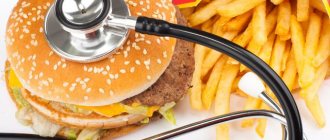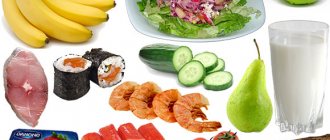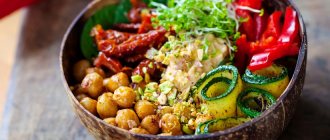Sports nutrition > Library > Shrimp - a valuable seafood product with a lot of protein
Once upon a time, shrimp were an exquisite delicacy that not many could afford. Fortunately, modern technologies for growing shrimp in special ponds have made this healthy delicacy more accessible. Already today, 1/3 of the shrimp sold worldwide comes from so-called shrimp aquaculture, with 75 percent of the market coming from China and Thailand and the remainder from Latin America and other countries.
Regarding the quality of shrimp, experts are unanimous in the opinion that of the two types - cold-water and warm-water (tiger shrimp, white shrimp) - shrimp that live in cold, deep waters have the best taste, and this applies to shrimp that live in both salty and in fresh waters. It is generally accepted that the best deep-sea shrimp live in the Norwegian fjords, as well as off the coast of Iceland, Greenland and Alaska. It should be noted that cold-water shrimp are much smaller than their tropical warm-water relatives, which still does not prevent their meat from being surprisingly tasty. Additionally, warm-water shrimp are most often farmed, while cold-water shrimp are wild-caught.
Chemical composition
Shrimp, like other seafood, is rich in easily digestible protein. Its digestion occurs very quickly, which facilitates the absorption of a sufficient amount of product components into the blood.
One hundred-gram serving of crustaceans provides 47% of the daily protein requirement. At the same time, they are low in fats and carbohydrates, and contain many valuable vitamins, micro- and macroelements.
Shrimp are a source of vitamin D. 100 grams (boiled) contain about 32% of the daily value of this important component. Vitamin D ensures the absorption of calcium and phosphorus and also regulates their levels in the blood.
If you compare shrimp and other products, then, for example, they contain almost 100 times more iodine than beef. So 100 g of this crustacean contains the daily norm of this element and 2.5 norms of potassium. By eating 200 grams of seafood per day, you can easily replenish the daily requirement of the human body for copper and cobalt.
Fresh shrimp are low in calories: 100 g of them contain 73-107 kcal (it all depends on the type).
This seafood is on par with potatoes, low-fat fish, and bananas in terms of calorie content. Cooking shrimp increases their calorie content. Boiled crustaceans contain about 100 kcal, and fried or baked ones become even more high-calorie. They can become an alternative dish for allergy sufferers, as they are a non-allergenic product. Table 1. “Chemical composition of shrimp”
| Compound | Contents per 100 grams |
| Squirrels | 18.9 g |
| Fats | 2.2 g |
| Water | 77.2 g |
| Ash | 1.7 g |
| Minerals | |
| Calcium | 135 mg |
| Potassium | 260 mg |
| Phosphorus | 220 mg |
| Sodium | 450 mg |
| Magnesium | 60 mg |
| Iron | 2200 mcg |
| Zinc | 2100 mcg |
| Copper | 850 mcg |
| Iodine | 110 mcg |
| Manganese | 110 mcg |
| Fluorine | 100 mcg |
| Cobalt | 12 mcg |
| Molybdenum | 10 mcg |
| Selenium | 38 mcg |
| Vitamins | |
| Vitamin A (beta-carotene) | 0.01 mg |
| Vitamin C (ascorbic acid) | 1.4 mg |
| Vitamin E (tocopherol) | 2.27 |
| Vitamin B1 (thiamine) | 0.06 mg |
| Vitamin B2 (riboflavin) | 0.11 mg |
| Vitamin B9 (folic acid) | 13 mcg |
| Vitamin PP (niacin) | 1 mg |
How many calories are in shrimp
Shrimp meat poses no risk to your waistline. What these crustaceans do not fatten, even under ideal conditions, is fat. Different types of these crustaceans contain from 0.7 to 2.3 grams of fat. Their calorie content ranges from 70 to 115 calories per 100 grams. For comparison, boiled chicken breast has at least twice the calorie content. The fewer culinary manipulations are performed with the shrimp, the more useful substances will be retained in it. The ideal option is to steam these crustaceans. In this case, their calorie content will be minimal.
Beneficial features
Benefits for the Heart
They increase the level of “good” cholesterol in the blood, and reduce the level of “bad” cholesterol. Serious cardiac pathology is caused by an excessive amount of “bad” cholesterol. B vitamins also have a positive effect on the cardiovascular system - they destroy harmful homocysteine molecules that impede blood flow and damage blood vessels. This type of crustacean is characterized by a high content of omega-6 and omega-3 acids, which help human blood vessels remain elastic and healthy, prevent the possibility of heart attacks and reduce blood pressure.
Cancer Prevention
Selenium, which is part of shrimp, prevents the formation of cancer cells, inhibits their growth, and also kills weakened, old cells, with a broken gene apparatus. This trace element is also capable of activating the activity of glutathione peroxidase, which has anticarcinogenic properties. There is information that the fatty acids contained in shrimp normalize metabolic processes, reducing the risk of colorectal cancer.
Benefits for the nervous system
Fatty acids have a positive effect on cognitive functions of the brain. The high content of omega-3 fatty acids helps prevent decline in the quality of mental activity and provide protection against Alzheimer's disease and dementia. Scientists at Columbia Medical Center have proven that fatty acid compounds help reduce blood levels of amyloid beta, the protein found in amyloid plaques that occur in Alzheimer's disease. With the regular presence of fatty acids in the diet, the risk of these terrible diseases is reduced by 30%. In addition, omega-6 and omega-3 acids improve your mood and help prevent depression. Magnesium contained in shrimp has excellent anti-stress properties.
Antioxidant properties
Shrimp is an excellent antioxidant. The carotenoid substance they contain, regularly entering the body, promotes the formation of new tissues and cells, prolonging their youth, and helps reduce the risk of developing cancer.
Antimicrobial properties
Chitin, found in the shell of a crustacean, has antimicrobial properties and helps the rapid healing of cuts and wounds. Also, thanks to this, it is used in dentistry and the food industry.
Benefits for bones
The high content of vitamin D and calcium in shrimp helps strengthen the skeletal system. It is useful to consume this seafood for patients suffering from osteoporosis and arthrosis of the joints. With its regular presence in food, the risk of developing muscular and bone dystrophy is reduced, ligaments and joints become elastic, and the skeleton becomes strong.
Strong aphrodisiac
Shrimp are a strong aphrodisiac. Their high content of selenium, iodine, protein, lysine and vitamins normalize hormonal levels, improve mood and give strength. Thanks to this, both men and women have increased sexual desire.
Benefits for women
During pregnancy, every woman is concerned with issues of balanced nutrition. Nutritionists advise pregnant women to include seafood in their dishes, the beneficial properties of which contribute to the favorable development of the fetus. The rich mineral composition improves metabolism, having a beneficial effect on the endocrine system, the appearance of nails and hair.
Shrimp are an irreplaceable source of microelements not only during pregnancy, but also during menopause.
Benefits for men
Seafood is very beneficial for the body of the stronger half of the population, and shrimp are no exception. In ancient Rome, crustaceans were part of the dishes for the patricians; they allowed them to stimulate their male power due to their zinc and selenium content. Fatty amino acids are involved in the biosynthesis of the main male hormone - testosterone. After dinner, where the menu included shrimp and accompanying products, such as vegetables, rice and white wine, a romantic continuation is guaranteed.
Using shrimp
In cooking
Shrimp are an accessible and at the same time exquisite table decoration that is accessible to almost everyone. What dishes can you add them to? Of course, salads - in them, tender, cold and almost melting in the mouth crustacean meat, together with spices, fully reveals its unique delicious taste. They can also be added to main courses. Some gourmets make soups from shrimp. And of course, just regular shrimp without any ingredients are common.
Recipes from different chefs differ in the variety of flavorings added and the cooking time. What is the secret to cooking shrimp? How to cook them so that the meat is completely cooked and tasty?
Proper defrosting of the product plays an important role in cooking. There are rules that will allow you to retain more nutrients in it:
- You cannot defrost shrimp at room temperature, in the microwave, or throw them frozen into water. The optimal preparation of the product for cooking is gradual defrosting and thawing in the refrigerator for 10-12 hours.
- A less “correct” but also effective way of defrosting is to place the seafood in a colander and leave it in cold water for 15 minutes. Then you need to change the water and let the shrimp sit for another 20 minutes.
- After defrosting, the seafood should be rinsed in running water. Before throwing it into boiling water, you need to dry it on a paper napkin.
Let's move on to the recipe itself. First, boil the water. Its quantity is determined in the ratio of 1 part shrimp - 2-2.5 parts water.
The water needs to be salted and spices added to it. The most common are parsley, black peppercorns, and dill. Sometimes a bay leaf is added, but you need to remember that it will add excessive toughness to the shrimp. But it all depends on your preferences.
After the water boils, you can put shrimp in it. Make sure that the dish does not “run away”, as crustaceans may foam slightly during cooking and rise to the surface. Tender and soft shrimp meat cooks very quickly - as soon as the shrimp boil and float, after 1.5-2 minutes they can be removed with a slotted spoon or drained. The cooking time for larger seafood products increases slightly - about 2-3 minutes. It is very important not to overcook - otherwise the meat will become a “rubbery” consistency and instead of enjoying it, you will only need to chew the elastic hooks. The meat of properly cooked shrimp is very tender and practically melts in your mouth. Once the seafood is removed from the water, it must be cooled and cleaned. If desired, you can sprinkle a little herbs before serving.
It is important to know how to properly peel a shrimp in order to eat it. First, it is imperative to free it from its shell. To do this, you need to pick it up with its belly up and tear off its head. Then you need to take the shrimp by the upper part with one hand and by the tail with the other, pull slowly by the back part and the shell will slide off the body. After this, you can enjoy the taste of crustacean.
The paws may contain caviar, which some gourmets eat. It is no less tasty than the shrimp itself.
When cleaning a shrimp, it is necessary to remove the “vein”, which is the digestive organ. It may contain grains of sand, and the taste is sometimes bitter. Of course, we expect completely different sensations when feasting on shrimp.
Shrimp, regardless of their type, can be cooked not only in water. For example, many seafood in Italy are cooked with cream or milk in an unrefined form. In Japan and China, in order to eliminate the specific “fish spirit”, green tea is used to prepare shrimp. Its leaves are added to the water just before boiling. In this case, the shrimp need to be cooked a little longer. And as a result, the meat will not be tasteless and “rubbery”, but, on the contrary, with an additional zest. In Russia, many people cook shrimp in vodka or beer. The most common ingredients added to the liquid when cooking crustaceans are bay leaves, salt, black pepper, lime, lemon, vegetable oil, cloves, garlic, tarragon and dill.
All of the above tips can be used for gas or electric stoves. You can also cook shrimp in the microwave. But in this case there is no consensus on the required cooking time. Some believe that these seafood should be kept in the microwave for 12 minutes, and it should be turned on at full power. Others are of the opinion that only two minutes is enough for such a procedure. Still others stick to the golden mean; they cook seafood on medium power for 5-7 minutes. But almost everyone agrees that frozen shrimp can be cooked in the microwave without water, because the melted ice will completely suffice.
Sometimes frozen-cooked shrimp are not cooked at all because they are already cooked after being caught. You can just wait until they are completely free of ice, sprinkle them with lemon juice, sprinkle finely chopped herbs on top and serve. Sometimes shrimp are “warmed up” by steaming. All of the above cooking methods are correct and acceptable.
For weight loss
Shrimp are low in calories, they contain almost no sugar and fat, but due to their high protein content they perfectly satisfy hunger. Therefore, this seafood is one of the most preferred types of food. The high content of vitamin B12 promotes hemoglobin synthesis and has a positive effect on the nervous system, which is important during weight loss.
There is a special shrimp diet that will help you not only improve your figure, but also improve the condition of your skin and hair. With this diet, you need to eat about 350 grams of boiled shrimp meat per day. If you really want fried food, then only cook it in vegetable oil and no more than 100 grams. You can eat vegetables with this crustacean, with the exception of potatoes, legumes and corn. You can eat greens in unlimited quantities. Green apples, citrus fruits and wild berries are allowed. Liquids allowed are water, citrus juices, pineapple, apple, pomegranate, and skim milk.
The duration of such a diet is 7-10 days. It is not suitable for people suffering from liver pathology or chronic allergies. It is advisable to discuss the need for such a diet with your doctor if you have problems with the thyroid gland.
In cosmetology
When eating sea crustaceans, the condition of hair, nails and skin improves due to the presence of vitamin A in their composition. But they are used for cosmetic purposes not only as food. The chitosan contained in the shell helps slow down the aging process, prevent the appearance of wrinkles, and normalize immune reactions. It is used for cosmetic correction because it does not leave scars on the skin.
Chitosan also has other excellent qualities: it creates a protective layer on the skin, protecting it from moisture loss. It also prevents from the aggressive effects of environmental factors and is perfectly absorbed by the body.
There is a whole series of different cosmetics based on chitosan: creams, lotions, masks, powders. Scientists are developing technologies that plan to use chitosan nanoparticles in new skin care products.
Dietary shrimp recipes
Let's look at a few dishes whose recipes are simple and yet healthy:
| Salad with seafood and vegetables: | You will have to chop the Chinese cabbage, cut the cucumbers into half rings, add the tomatoes, cut the hard cheese into cubes. Add greens to the bowl, a few grams of boiled and peeled shrimp. You can grind them. Season the salad with olive oil, add salt and pepper to taste. |
| Rice with seaweed and shrimp: | Boil the rice without adding salt; it is better to use steamed or brown rice. Prepare seafood and mix it with kelp. You can use asparagus instead of seaweed. Rice serves as a side dish, complemented by shrimp and kelp. |
| Salad with eggs and potatoes: | Boil small potatoes and sawn eggs. Then cook the shrimp. Chop the herbs (dill, parsley, basil). Mix all the ingredients, first cutting the potatoes into cubes and the eggs in half. Take lemon juice and olive oil and use the mixture to season the dish. |
It is not so important how much protein shrimp contain, since this product has a unique composition. It will not only help cope with an attack of hunger, “saturate” the body with useful substances, but also improve a person’s health. But you should not overuse seafood, as this can lead to undesirable consequences.
Recommended video:
Read along with this article:
- Is it possible for a nursing mother to boil a boiled egg - the benefits of the product and possible harm
- How to eat sprouted wheat and how it is beneficial for…
- Foods containing large amounts of protein: benefits for the body
- The ABC of taste: calorie content of smoked capelin
- Goji berries - calories, beneficial properties
- Beneficial properties of capelin and its calorie content
- Do sunflower and pumpkin seeds make you better?
- Red beans: beneficial properties and cooking recommendations
- Beneficial properties of hemp and its effect on the gastrointestinal tract
Selection rules
The best option is to buy shrimp immediately in the harbor after unloading from the ship. But, unfortunately, few people live in such a place. The majority of people choose this seafood in markets or stores, where they are available in chilled, canned or frozen form.
The healthiest ones are fresh frozen shrimp, because in this form they retain the components included in it to the maximum. But most often you can find frozen boiled seafood on our shelves. It is best to buy it frozen in a block.
In order to fully enjoy the benefits and taste of shrimp, you need to carefully examine their appearance. They should definitely smell a little like the sea and look fresh. What else should you pay attention to when choosing?
- The freshness of the shrimp is indicated by its elasticity and low moisture content. Too dry a shell indicates old age.
- There should be no spots on the sea crustaceans. Black rings or spots on the paws indicate that they are spoiled or old. When cooked, such individuals will turn into mush. Yellow spots indicate that sellers tried to hide the presence of black spots using a chemical solution.
- White stripes on seafood indicate that it is frozen.
- There is nothing wrong with a shrimp having a green head - it has just been feeding on plankton for a long time. A brown head indicates that this is a female and she is pregnant - such shrimp are much healthier.
- If the sea crustaceans are brown or yellow, then this is evidence that they have been lying on the shelf. Do not buy bright or almost red ones with an orange tint, because they are most likely simply tinted to give them a marketable appearance.
- Shrimp in the form of a frozen lump occurs if it has been defrosted and re-frozen.
When making a purchase, be sure to pay attention to the shelf life, otherwise there is a risk of purchasing a damaged product. It is better to cook shrimp immediately after purchasing. But if there is a need to store them, it is better to do this in the freezer.
What to consider when choosing and purchasing shrimp
The purchase of seafood is carried out in compliance with certain rules:
- pay attention to the country of origin; shrimp from South Asia are of low quality, while the best are from Latin America;
- study the expiration dates of the goods, pay attention to the storage conditions;
- if you buy packaged shrimp, inspect them for the presence of large quantities of ice;
- there should be no spots on the crustaceans; if there are yellow or dark spots on the shell, then it is better to refuse the purchase;
- when the legs of the shrimp become dark, it is possible that the product may be treated with chemical reagents; there will be little benefit from such food;
- lumpy, uneven shells of crustaceans directly indicate a violation of storage rules.
Read: Nutrition during colostomy - basic principles of diet
It is better to purchase unpeeled shrimp, since after heat treatment their meat will be juicy and soft. Those that have been purified cannot boast of such characteristics.
Recommended video:
Specimens that are too large in size should alert the buyer. There is a risk that such shrimp were grown under artificial conditions, using antibiotics and growth stimulants.
Additional facts
Shrimp lovers will be interested in learning a few interesting additional facts about them:
- Many species of shrimp are hermaphrodites—they can change sex from male to female throughout their lives.
- As they grow, they molt and exchange their old shell, which has become uncomfortable, for a more spacious one.
- They can easily accumulate toxic substances.
- King shrimp are grown primarily on farms. For this purpose, growth stimulants and antibiotics are used. They contain very few nutrients.
- One type of shrimp is the so-called “shooting” shrimp. With their claws they can make a click so loud that the fish located nearby die from it.
Negative effects on the body
In some cases, after eating shrimp, allergic reactions may occur, which manifest themselves in the form of rashes. Sometimes there are malfunctions in the functioning of the digestive organs. As a rule, side effects are possible in the case of individual intolerance to seafood protein by the human body.
Since fried shrimp contain a lot of cholesterol, it is not recommended to consume them in large quantities. They are especially contraindicated for gastrointestinal diseases in the acute stage, problems with heart function.
On a note! Unfortunately, the quality of products sold in modern stores is often questionable. This also applies to shrimp. They can also be grown using growth promoters, antibacterial drugs and hormonal agents. It is not recommended to consume such seafood. The benefits from them are much less than the harm.











